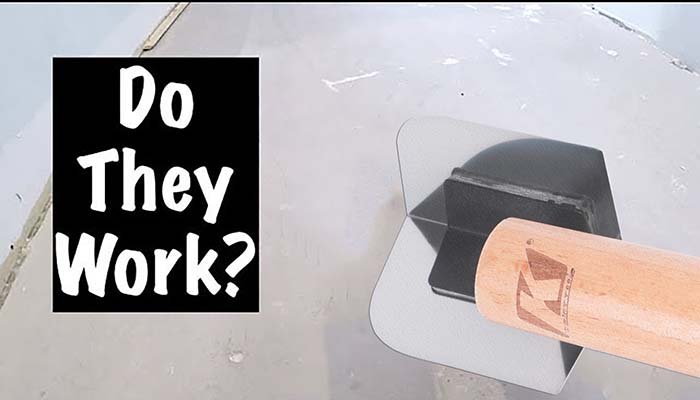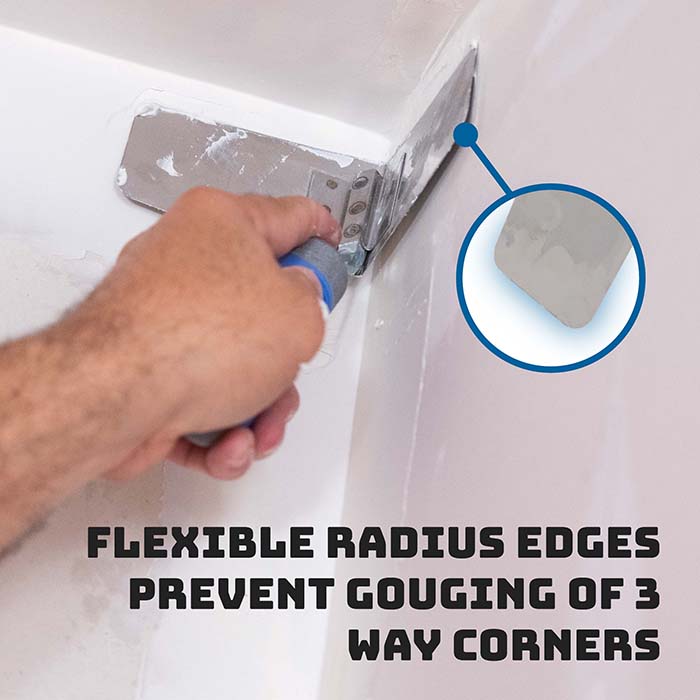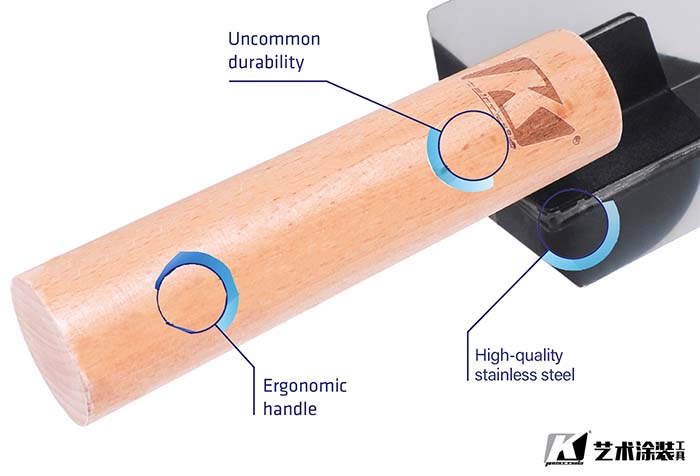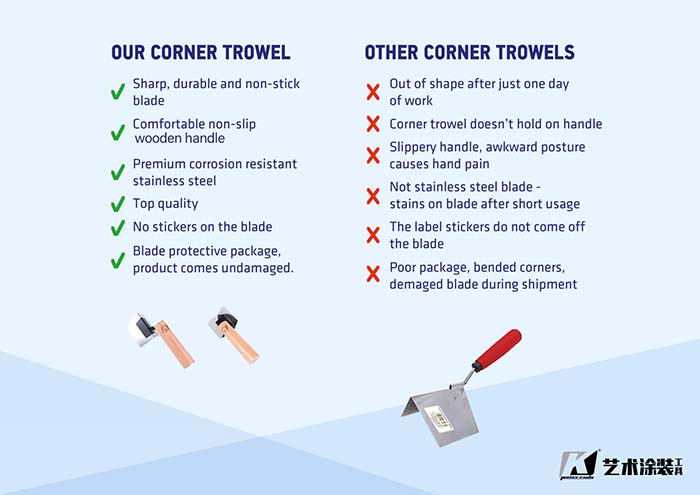
When you are plastering a room or putting up drywall, one of the hardest and most frustrating bits to get done can be the corners – especially the hard-to-reach ones.
And typically, it is the first bit of plastering in a room that needs to be right, in order for it to look like a good job. It's important to have a smooth, sharp corner inside and outside the wall, so it's a good idea to use a corner trowel to achieve this.
A corner trowel is a type of specialized tool that can be used to spread mulch, remove weeds and plant bulbs, to lay mortar in wall corners. They are shaped like a triangle with a sharp edge on one side and a flat end on the other. It features an L-shaped end that allows the user to apply mortar into tight corners, or against obstacles where it would be difficult or impossible to properly apply the product with the standard trowel.
For many newbies and veterans, they still don't know Corner Trowel. Many benefits of using a Corner Trowel (Drywall Corner Finisher) - You can save time by getting your corner right the first time. It can also mean you have to go over the same spot fewer times and when hard to reach corners are involved there’s less chance of you having a sore arm at the end.
As a handheld device, it fits perfectly into corners, making it the ideal tool to enable flatter, smoother surfaces in the end. While most corners will be 90-degrees, these corner trowels can also come as an adjustable tool or in a variety of sizes to ensure it fits whichever angle you’re going for.
Many also have a soft grip handle to go easy on your hands and the blade can be made of stainless steel and rust-resistant to ensure long-lasting use. Although there are some good products on the market, but hard to find good suppliers of corner trowel.
Our goal is to finish the job faster. For years, plasterers have debated whether they need a corner trowel when finishing corners, but one thing remains certain. If used properly, with the correct amount of pressure applied, a corner trowel will help you finish the job faster, leaving better results in the end. Additionally, it'll leave you less achy and sore afterward because getting those corners right is less of a struggle.
Also, a corner trowel comes in handy if you're taping corner joints when putting up drywall. After you’ve used the drywall knife to apply the mud to your corners, all you need to do is measure a piece of drywall tape that’s the length of the wall and fold it in half.
Apply the drywall tape fold to the corner and press it tightly to the wall, squeezing out any excess mud. Making sure you squeeze out the excess mud will reduce the bubbles and help the compound to dry faster. When flattening the tape and removing any excess mud, you just run the trowel down the corner, from top to bottom, using moderate pressure. You can then smooth a layer of mud over the top using the trowel again.

No matter if you are plastering a wall or putting up drywall, one of the most frustrating parts is trying to reach the corners. Smooth, sharp and correctly plastered corners set up the finish for the entire wall, so it is crucial to get it right and use the right tools to achieve this. A corner trowel is worth its weight in gold when it comes to these tricky to tackle areas of plastering, and is a tool every respectable plasterer should have in his or her kit. We've been taking a closer look at the benefits of corner trowels.
Getting the job done to the same high quality but in less time is every tradesman's dream, which is why automated tools and targeted area tools sell like hot cakes. Learning how to use a corner trowel is essential for faster finishing, but once you have mastered it and apply the right amount of pressure you will see flawless finishing in half the time.
As touched on above, tackling the hard-to-reach corners and areas is every plasterer pet peeve, but with a corner trowel you can reduce your frustrations thanks to the angles on the tool provided that will make it much easier to tackle those hard-to-reach places with ease.
You may be wondering if a corner trowel is worthy of the investment when it seems the only function is easing corner plastering. It can also be useful when you are trying to tape a joint when drywalling. Apply the drywall tape fold to the corner and press it tightly to the wall, squeezing out any excess mud. Making sure you squeeze out the excess mud will reduce the bubbles and help the compound to dry faster.
With moderate pressure you just run the trowel down the corner, from top to bottom, flattening the tape and removing any excess mud as you go. You can then smooth a layer of mud over the top using the trowel again. We know that, the high-quality of Inside Square Corner Trowel is made of stainless steel with a steel mounting.
It is designed for use with concrete and cement and will form inside square corners wherever these are required, such as on steps. So that, we love these trowels, good quality product at an excellent price. Flexible stainless-steel blade, flexes for perfect 90° corners and handle for extreme comfort.
To Use a Corner Trowel, you should hold it in your hand with your thumb pointing down towards the ground and then drag it across where you want to work. The pointy edge will help loosen up any dirt while the flat edge helps scoop out weeds or soil from hard-to-reach places.
1. Ensure that the wall is firm and dry before applying tile setting material. The best time of year to set tile is during spring or fall when humidity levels are low.
2. Begin by measuring the wall and marking a reference point.
3. Mix your tile setting material according to manufacturer recommendations. Once mixed, use a grout bag or bucket to fill the corner trowel with the mortar product of choice.
4. Position yourself at one end of the corner and place the corner trowel up against it.
5. While applying even pressure with your dominant hand, use the trowel to scoop mortar out of the corner. Apply enough material so it begins to pile higher than the height of the trowel.
6. With your free hand, apply a thin layer of mortar along the wall using either your mud knife or pointing trowel.
7. Hold the corner trowel at a 45-degrees angle from the wall, and use it to scoop mortar from the pile on the floor. Apply pressure with your dominant hand while you pull up and press into position with the corner trowel.
8. Smooth surface of mortar into place using your pointing trowel or mud knife. Allow the mortar to completely dry before proceeding with your project.
In the end, we conclude that corner trowels are useful for planting small plants such as tulips or daffodils close together without damaging their roots too much. It can also be effective when trying to apply mortar in small areas, such as under sinks or between cabinets.
A drywall worker named Thomas from Brazil, who is definitely a novice when it comes to finishing drywall. Thomas has done loads of patching, which doesn't typically require working with corners. This time, however, he is doing it the whole room.
After watching a few YouTube or Vimeo videos and reading a few articles online, he learned how to properly finish inside corners. Everybody makes it look so complicated, but he just can't seem to get the hang of it.
1. Put some drywall compound on each side of the corner.
2. Fold the paper tape in half.
3. Press the tape into the mud.
4. Place a corner trowel in the corner, and with gentle pressure on the back of the trowel draw it down (or up) the corner.
5. The first problem I was running into, was that instead of the trowel sliding along the tape. The tape was being pushed along by the trowel, and it would bunch up and be removed from the corner. I solved this by pressing a bit more gently, and holding the tape in place just to get started.
The next problem Thomas ran into was that while he slid the trowel down the corner, the tape would ripple and bunch up ahead of the trowel. To fix this, he had to use my tapping knife to smooth the wrinkles out of the tape. While this worked in the long run, it seemed less than ideal. This extra step was never mentioned in any of the videos or articles, which made him wonder what he was doing wrong.
Question of Thomas: Am I adding too much (or not enough) compound to the corner? Applying too much pressure with the trowel? Or do I just need to work on my technique?
I'm interested in what a more professional opinion there is on this. I am preparing to mud a whole room for the first time, but I've only ever used the fiberglass mesh instead of true paper tape. Maybe it's related to the tackiness/lack thereof of Thomas' compound?
I have watched some drywall guys and have a much lengthier adaptation to what they do. Note: Thomas' drywall mud should have the consistency of a very oily peanut butter. The premixed stuff in buckets at big box is too thick. Add a little water and a couple of drops of Dawn to it. If it is too-dry you may find more air pockets and your tape not binding well with wall. But if too-wet your tape will tear when trying to squeeze of the mud.
They don't use a corner knife and either do I. I find that I end up moving the paper or ripping it. To apply the layer of mud before the tape I either use a 2-in drywall knife vertically or a much larger knife in horizontal swipes. And this next tip is definitely stolen and the key - scrape off the excess mud with a 10-16" knife. The putty knife is flat against the wall so this should make you scrape until your corners are 90 degrees. Most/all corners dip in due to screwing.
If you do this just right you will leave a very thin strip of excess mud down the middle which is fine. The goal is that your mud should be 2-3 inches out of corner all the way down both sides. Fold tape in half and start from top. Press corner tape firmly into corner but do not push hard. Go all the way down just using your finger. Cut tape to size.
With larger knife (10" and up) start at top. Put knife in corner and lightly press out horizontal on tape with a horizontal/down motion (obviously the very top is more horizontal). Do a couple swipe on one side of the corner tape and then do the other side and work your way down.
Excess mud should come out during step 4. If there is a ton then step 2 was done incorrectly. If too much mud your tape may get to wet and rip. If you find yourself in this situation it is much easier to remove tape and start with step 2.
To remove the small excess-mud take a 6" knife (or bigger if you are more skilled) and start at the top corner on one side and swipe from top to bottom. I have seen my pros do this in one swipe. You will have more pressure on the knife towards the corner but not so much that you tear or move tape. The excess mud is good/fine and it should be thicker right now so the tape binds to wall well.
Given you aren't just doing inside corners (and always try to do inside corners first) go back to this corner about 30 mins, maybe an hour. It should be kind of dry - if it still looks sopping wet don't touch it. Put your first coat of mud over the tape on one side of the corner. Use a 4"-6" knife. The key to this coat is that it should be flat. Instinct is that you would have more mud in your corner and smooth down to flat wall. No. Your corner should not be built up and you shouldn't be worried about smoothing to drywall until at least the next coat....and this is where I really diverge from my pros.
I wait 1-2 days depending on type of mud and room conditions. I want everything 90% dry. If I put the first coat of the other side of the corner on. I would certainly mess up the opposite side. My pros do these at the same time, hardly ever mark the other side and when they do that, they don't spend 20 mins trying to fix it like I do. Again, this is a 4-6" knife done flat. So that, to recap we put our tape down and first outer coat on just one side in day one and day 2-3 we will do the other side.
Again, differing from my pros. Here my pros would bust out a 12-16" knife put a crapload of mud in the corner and it would look perfectly feathered in 2-3 mins a corner. Also, it would take very little sanding after. I have no ability to do this so I bust out an 8-10" knife and put my second top coat on.
Scrape any bumps or ridges with 6-inch putty knife after step 8-9 dries. Probably a day later unless using quick set. Put down finish coat with 12-16" knife, and any bumps or ridges with same knife a day later, sand with 120-grit. Finish sand with 240+grit.
Tell yourself that because it took longer it is better [Even though I see far more pinholes in my finish than my pros - they are obviously cheating]. Actually, the pros method that I have seen actually does take as long technically because their top coat is so heavy that they often have to wait 3 days to sand it. Now they would say but we only had to work on it twice vs. my 4-5 times but that is semantics. Both done on the same day.
Being said aside from the consistency of the mud, the things that we have found for inside corners are: Make sure that the mud is evenly applied on both walls (uniform thickness on both walls and smooth) and has no bubbles. It's easier to under apply mud than over apply it.
Apply the mud with a 4-6inch knife, and smooth it with your corner trowel. When putting the tape in the corner, put some tension on the tape. This may be what you're doing wrong. Press the tape in gently with a 4-6inch knife. For the first two feet or so, hold the tape in place at the top as you work the corner trowel downward.
Don't use a corner trowel to set the tape - the extra surface contact, and the pressure required, drags it out and through the joint. A corner trowel cannot be used effectively, as the sole tool in a corner - period. They are typically, only 4" wide, from corner to edge, and are intended for the finish stroke, that defines the corner - not the stroke that sets the tape in the mud.
Only use the corner trowel to level out your "bed" for the tape, and the finish stroke, to define your corner. You must still use a flat knife (normally a 6") to put the mud on the wall, set the tape, and feather the ridge left by the corner trowel. An additional step, would be to follow up the next day, with an 8", to blend (skim) it further into the wall.
If Thomas want to spend a lot of time, teaching yourself, the precise amount of mud, and the precise amount of pressure, needed to accomplish his goal - without a good corner trowel - more power to do work - but that's what it will be, a lot of time. Drywall finesse, is really difficult to explain/teach, in a text environment, and even YouTube videos fall short. The brand/type of tools used, consistency and type of mud used, and even the temperature and humidity, of the room being finished - all tug and pull, at what makes sense, in his hand today, but might not be the case tomorrow.
While the mud is still wet, any knife stroke will slide the tape if not enough squeezing force is applied. What this squeezing does is press the excess mud from behind the tape; the less wet mud, the more friction between the tape and the drywall facing, and the less sliding/wrinkling is possible.
Many people have never used a corner trowel for taping, and I think that it might be the reason you're wrinkling the tape. It might not be squeezing enough mud from behind the tape.
To squeeze the tape with the least amount of possible damage to it, place one 6" knife corner in the inside corner, tilt the blade 45 degrees or more toward the direction you're pulling it, then apply enough pressure while drawing the knife that the mud squeezes almost completely out from behind the tape, taking care not to tear the corner crease with the knife corner. Then repeat on the perpendicular side of the corner.
My method once the mud is up is to apply the tape lightly over the whole length, then draw the knife upward over the top couple feet, holding it in place with my free hand. Then once the top couple feet is good and tight, I step off the ladder and finish by stroking downward the rest of the way: the top couple feet is stuck hard enough that the tape won't slide.

In preparation for taping and mud the 'inside corners' of a diagonal attic ceiling, we are planning to reattach the short walls to the ceiling. What would be the best method for achieving a straight line? Is there a special tool we can use? Free-handing is not working for us. Our 90-degrees trowel works fine for vertical inside corners, but of course the 'corners' we are trying to do are horizontal.
I've had decent luck not taping inside corners at all. Instead of I've use a sanded caulk. The key is to have a nice sharp edge to work with where the two pieces of sheetrock meet. But if you want to mud and tape, there are tools for that - K Brand Corner Trowel.
Corners can be one of the hardest and most frustrating areas to plaster which means you need to make life easier and save yourself precious time with a corner trowel. A plastering tool that’s specially designed for this purpose. Like all our tools here at G.SB, our corner trowels have been handpicked by our expert team who have years of experience in plastering and have used these tools themselves.
One of the main benefits of a corner trowel is that you don’t have to go over the same spot over and over again, which can not only take time, this also poses a high risk of repetitive strain injuries. As we handpick and test all our plastering tools, we’re always on the look-out for attention to detail. Features such as soft-grip ergonomic handles offer comfort and make tricky jobs easier and more enjoyable. Choose from our top brands.
We also offer both plastic and stainless-steel corner plastering trowels. Stainless steel is a traditional material that professionals rely on time and times again for durability, while plastic offers flexibility – perfect if you’re after a corner trowel for DIY or are a newbie learning tricks of the trade.
We offer a range of tools for corner work, including the standard internal and external corner trowels, which it is meaning they are rust free. We also have an adjustable angle corner trowel that allows for use on a variety of splayed internal angles, which can be easily adjusted by the loosening of a wing nut
The adjustable square and angle tool is ideal for use on reveals and window frames. Both the adjustable angle corner trowel and square and angle tool are manufactured from stainless steel meaning they are rust free.
Everything a plasterer in the trade needs to operate day to day. Each tool has been crafted to benefit the user and leave a seamless finish. From scratch tools, to spatulas and bucket trowels, G.SB provides it all. All tools are made from stainless steel and most are available in a variety of different sizes. Everything you need from one brand.

Once the grunt work of lifting and fastening drywall is done, the finer (and messier) work of finishing begins. The equipment you need for this stage includes basic tools for mixing, taping, finishing ("Drywall Corner Mudding/ Corner Mudding Tools") and sanding. Only four tools for finishing are absolutely essential: a mud pan, two drywall knives and a sander. But a few others can help the job go more smoothly, quickly and cleanly.
Corner trowels smooth both sides of an inside corner at the same time. This is an optional tool but can be worth it when there are a lot of inside corners to tackle. The alternative is using standard taping and finishing knives to finish each side of the corner separately; and it can be tricky to smooth one side of the corner without scraping the edge of the knife onto the adjacent side.
Copyright:@2020-2021
Comments Please sign in or sign up to post.
0
0 of 500 characters used